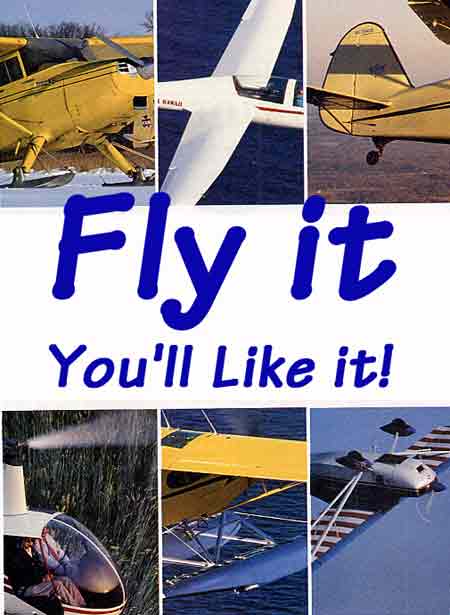
"Keep the spice in your flying by straping on something new"
Budd Davisson, Flight Training, September, 2003
Paddling Around the Edges of Aviation Never Gets Boring

"Keep the spice in your flying by straping on something new"
Budd Davisson, Flight Training, September, 2003
Paddling Around the Edges of Aviation Never Gets Boring
Did you ever notice how a Private Pilots License (PPL) that’s only a few hours old feels as if it’s an inch thick and alive? Even though it’s made of dead trees and measured in thousands of an inch, for the first day or two after earning it, just the knowledge that it’s there makes your wallet seem impossibly thick. And you can almost feel the license throbbing as you carry it around. Don’t lie: how many times did you take it out to make sure the whole experience wasn’t a dream. You actually do have your PPL. You’re now officially a pilot!
Now what?
The next few hundred hours are predictable: first, every member of our family and all of our friends are taken for rides. Then we begin a systematic search to root out every greasy eatery that’s located on an airport anywhere within an hours flying time. Fly-ins are added to the go-to list. Then maybe we plan that long cross country we’ve always dreamed about, although more often then not, the planning is done and re-done, but the trip is overtaken by events and never happens.
Then what?
Unfortunately, after a few years of this, some of us start to find other things drawing our interest. Soon, we don’t go to the airport as often as we did and we drift away from it. We’ve done what we can do within the limits of what we learned while earning our PPL and, as impossible as it sounds, some of us get a little bored.
Some folks are bound to say that’s it’s impossible to get bored, no matter what kind of flying you’re doing and, in their case, they may be right. But that’s not the way it is with everyone. Many are attracted to aviation because of the challenge of learning and because it opens new horizons. Once the challenge goes away and they’ve explored as much as they can explore, they go looking for new challenges and new horizons. Too often they look outside of aviation for that, when in actual fact, aviation is so wide and varied a person can spend a lifetime exploring it and never experience it all.
The PPL should be seen as the ticket to Disney World and it does nothing more than open the door to untold experiences, each totally different from the last. And just as Disney World is separated into different kingdoms, each with its unique rides and experiences, so is aviation.
Although it’s difficult to divide all of aviation into neat little kingdoms, we’ll take a shot at it. In the first place aviation tends to divide itself into two major worlds: “Mainstream” or general aviation and what we’ll label as “Recreational Aviation.” Mainstream aviation is your Cessna/Piper/Beech variety that includes all the basic flight training and the cross-country family airplanes that everyone tries (unsuccessfully, we might add) to rationalize as making sense. Recreational Aviation includes everything that’s done to either scratch an itch, illicit a grin or generally make the pilot feel good. No rationalization needed here. Further more, the Recreational heading also includes Sport Aviation, which has been neatly categorized by the EAA and the world in general to include, but not be limited to, Homebuilts, Antiques, Classics, Warbirds and Ultralights.
Where “Mainstream” aviation is fairly narrow in terms of airplane types (Cessna/Piper/Beech) and purposes ($100 hamburgers/transportation), Recreational Aviation covers an impossibly broad world of types and experiences. This split of Recreational versus Mainstream is an arbitrary categorization we just made up so don’t go to your AIM trying to check our definitions.
Regardless of how you try to categorize aviation, the important factor to recognize is that there is absolutely no way anyone should ever get bored within the confines of aviation. None! Once you include what we’ve loosely defined as Recreational/Sport Aviation it becomes such an incredibly wide, diverse world that is so varied in terms of aircraft types, financial requirements, experiences offered and training required that it is nearly impossible for an individual not to find at least a couple of niches that fit them like a well worn pair of high-quality boots.
Out-of-the-Mainstream Aviating
Some of the non-mainstream forms of aviation have been around for generations and are formally recognized as ratings. A few others are further down the FAA-recognition chart and require endorsements. Others exist in their own world, as if the FAA doesn’t know they exist.
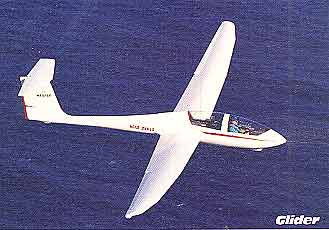 Most endorsements have to do with different airplane configurations, not types. For instance, the need for a glider rating is obvious. It’s a different type of flying machine. The tailwheel endorsement is a minor configuration change that introduces a few new skills that are applicable to a broad range of similarly configured airplanes, e.g., get your tailwheel endorsement in a Citabria and, as far as the FAA is concerned you are good to go in everything from Taylorcrafts to S-2A Pitts Specials.
Most endorsements have to do with different airplane configurations, not types. For instance, the need for a glider rating is obvious. It’s a different type of flying machine. The tailwheel endorsement is a minor configuration change that introduces a few new skills that are applicable to a broad range of similarly configured airplanes, e.g., get your tailwheel endorsement in a Citabria and, as far as the FAA is concerned you are good to go in everything from Taylorcrafts to S-2A Pitts Specials.
In some cases just going for the required rating is good for a solid dose of interest-raising adrenaline. The helicopter rating is one of those. You may never set foot in another helicopter after getting the rating and they aren’t usually used to chase hamburgers, but just the challenge of the rating is good to keep you fired up for along time.
A few experiences, such as aerobatics and bush flying, aren’t recognized by the FAA, as being anything special so no endorsement is required. Commonsense, however, says some specialized training is in order. Plus, each of these skills is central to yet another whole new world to explore.
Some of the sub-categories of Sport Aviation, like classics, require the tailwheel endorsement if you expect to sample all the category has to offer, but once you have the endorsement, you’re standing in the doorway to a world of aviation that is as wide and as varied as mainstream aviation ever thought about being.
We’re going to attempt to give a brief tour of some of our favorite, non-mainstream aviation experiences and worlds. Use the following as a check list and work your way down it, faithfully sampling all each has to offer until you’re fully satisfied you’ve learned all there is to learn in each. If, after you finish living your way through this list, you start to loose interest in aviation that’s perfectly okay because by that time you’ll be 153 years old and it’ll probably be time to find something else to do anyway.
Skills, Ratings and Endorsements
You’ll notice we’ve purposely left the multi-engine rating and the instrument rating out of the following, because, even though they do a lot to maintain a person’s interest, they are very much a part of mainstream aviation. The rest of the following that require ratings or endorsements aren’t quite so mainstream.
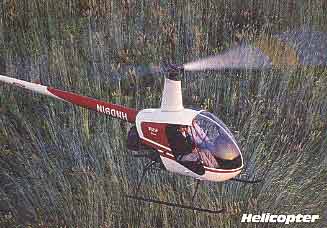 Helicopter Rating
Helicopter Rating
Of all the things we’re going to mention, this one probably requires more cash and presents more challenge than any other. While flying a helicopter is flying, it borrows only a little from other types of flying and invents whole new concepts that challenge you both mentally and physically. The good news, however is that it’s not an impossible skill, just one that keeps you working. Thanks to the introduction of the Robinson R22 to the training fleet, a lot more helo schools have popped up and the costs have come down.
Glider Rating
If you’re a licensed pilot you may be able to earn your glider rating in a long weekend, although it will usually take longer. Some will solo it in a morning. Although glider schools are less common in certain parts of the country, they are plentiful enough that a pilgrimage to the southwest isn’t required. The cost is what you want to make it with each flight costing about $70 so you can fly as much as your pocket book will allow.
Float Rating
This one you’ll probably have to travel to find the training. Fortunately, because floats require water and water generally means a resort environment, float training schools are often located in places you’d want to vacation anyway. Beware, however: float flying can become addictive. In some parts of the country, it opens up new vistas of places to visit and things to do. Although floats raise the price of acquisition of any airplane and complicate the care and feeding of said airplane, once you’ve been infected, many people wouldn’t fly any other way.
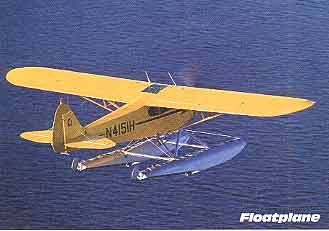
Tailwheel Endorsement
If you want to get into non-mainstream aviation, the tailwheel endorsement is probably the place to start. This is because just about every really interesting airplane and most of the non-mainstream activities involve the tailwheel. For some unknown reason, the tailwheel has gained a ridiculous reputation for being difficult to master, when it isn’t. Six hours of dual training, give or take a little, will do it for most pilots. That’s it! Six hours. It’ll make you a much better pilot and gives you access to so many interesting airplanes that you’d never be able to taste without that simple six hours of training. This is not an idle statement: the tailwheel is just not that big of a deal but it is crucial to widening your horizons.
Aerobatics
These days almost any city of any size has at least one akro school, although they tend to cluster in places where the sun shines. Aerobatics is at least as addictive as float flying, especially because many of the training airplanes, usually Pitts, Extras or Citabria/Decathalons, offer a peek into a world of serious performance. It’s hard to climb back into a Cessna once you’ve flown something like a Pitts or an Extra. Aerobatics requires nothing in the form of an endorsement or rating. It’s a giggle thing done for the helluvit and the fact it’ll make you a much better pilot. Depending on the airplane being used figure $100-$350/hr and you can spend as much or as little as you want. Be careful with this one. You can become a real akro addict without meaning to.
Skis
You don’t see a lot of schools teaching ski flying these days in the Lower 48 although Andover Flight Academy in Andover, New Jersey is one that comes to mind. However, this is one skill, that like floats, is truly a kick in the shorts and worth learning. It’s a non-endorsement skill you won’t use much in the southern tier, but it makes it much easier to make it through the long winters of the snowbelt knowing you won’t be grounded until spring or until they plow the runway. Costs are about the same as any dual instruction.
Bush Flying
Again, Andover Flight Academy is the only place we know in the Lower 48 that actually has a bush-oriented training program and it’s worth the price of admission. There are probably other schools, but that’s the only one we know. Serious bush flying, where runways are in the 500-800 feet category is really fun, not to mention it demands the pilot know how to make the airplane go where he wants it to. The really hardcore stuff is guaranteed to light your wick. There is something magical about coming to a halt on a sloping, rocky piece of real estate that doesn’t look large enough even crash on, much less land on. It’ll raise all of your piloting skills and, at the same time, make you yearn for a trip north.
The World of Sport Aviation
The airplanes, which we are defining as being part of Sport Aviation, vary so much in type, condition and price that there has to be an airplane that will fit every bored pilot who is looking for an alternative to mainstream aviation. If you can’t find something here that blows your skirt, maybe you really are hopeless.
For convenience, we’re going define the world of Sport Aviation as those airplane types, which come under the umbrella of the Experimental Aircraft Association. If you don’t belong to the EAA, you should. The organization is action-central for everything having to do with non-mainstream aviating.
Contemporary Classic
For the benefit of this discussion, we’ll define the contemporary Classic as the mid to late 1950’s birds, almost all of which bled over into the 1960’s. This is the period, which, among other things gave birth to just about every single-engine, fixed gear airplane ever made by Cessna. Airplanes like the old squaretail 172s and 182’s offer classic appearances and grace with absolutely modern utility.
Piper products of the same period are a mixed bag because they were making the rag and tube Tri-Pacer at the same time the Comanche was being born and the Apache was their mainstay twin.
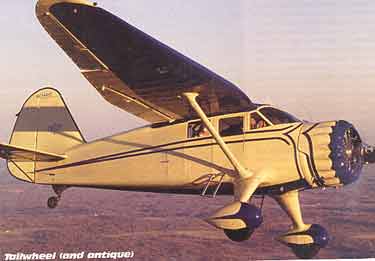
Classics
The loose definition of a “classic” airplane is anything built during the decade right after World War Two. There are some gray areas here since some pre-war airplanes considered antiques (Staggerwing Beech, for instance) were produced in some numbers after the war and many aircraft in production during the early1950’s soldiered on into the sixties. Still, the majority of the Classic genre are the result of the gross miscalculation by the aircraft manufacturing community that dumped over 38,000 airplanes on the market in 1946. Most of those were two-place personal flivvers ranging from the super-basic Cub to the super-sophisticated (relatively speaking) Swift. At the same time, however, don’t forget the Model 35 Bonanza is part of this same pack, along with Cessna’s sprightly 170 and burly 195.
The wonderful thing about classics is the fact that they offer affordable little entry-level two-placers like the bottom-of-the-totem-pole Aeronca Chief, Taylorcraft, etc. ($10-$20K) to middle of the road birds with modern utility like the Model 35 Bonanza ($35-$50K) to birds like the Cessna 195, which give you a Packard-like limousine for $75K, give or take a little.
You name it and it exists within the Classic category, but you’d better get that tailwheel endorsement because only a few classics were built with a nose wheel (Ercoupe).
Antiques
We’ll lump everything that was produced before WWII together as antiques, although that’s not entirely accurate. The smaller antiques, the very first Cubs, Taylorcrafts and Luscombes that went on to be produced after the war are affordable and relatively plentiful. As you go back to the first half of the 1930’s however, you get into similar sized airplanes with older engines and technology that are harder to support. The same thing is true of the bigger antiques like the WACO’s and Staggerwings. Big antiques are serious airplanes best attended to by serious people with serious money.
Homebuilts
Where the homebuilt airplane used to be looked down upon as being a crude imitation of a flying machine they have matured until the best technology in general aviation is now coming out of the homebuilt field. They lead the way in composites and high performance.
Although the high performance birds like the RV’s, Lanceairs, Glasairs, etc., are the most visible because of their performance, the homebuilt category contains over 500 designs that, to varying degrees can be built in your garage. They range from the lowly, 75 mph Pietenpol, to the fire breathing Pitts Special to the ultra-utilitarian, four-place Bearhawk and the 300 mph, pressurized Lanceair IV. From scratch-built to ready-to-assemble kits, if you can’t find anything here that satisfies you, you won’t find it anywhere.
As an aside: the homebuilding community has exploded and developed a sub-industry aimed at educating the wannabee builder so he or she is working as part of a community, rather than having to figure stuff out for themselves.
Warbird
No, the word warbird doesn’t automatically mean big bucks and hairy performance. In fact, military versions of Cubs, Aeroncas and Cessnas of the liaison breed are rapidly becoming a great entry-level airplane as well as an affordable warbird. Then, of course, if you have $300K burning a hole in your pocket, you can buy any one of a bunch of ex-military jets. Getting into the Mustang game, however, is going to cost you a cool mil, if you’re going to do it right. But then, if you have that kind of money, you probably aren’t reading this article anyway.
 Ultralight
Ultralight
Even though the weigh limits still are supposed to define what is and isn’t an ultralight, the type has mutated and given birth to a bunch of in-between airplanes that are heavy enough they require N numbers and are more real airplane than ultra light.
Sport Plane to Come
The really big news in the small airplane field is the probable approval by the FAA of the Sport Plane category. If that happens, little airplanes like Cubs and a myriad of other smaller homebuilts can be flown without a medical. It also opens the doors for manufacturers to build complete aircraft to those weight and performance specs without having to adhere to either the 51% kit rule or jump through the FAA’s certification hoops.
The bottom line is that there is never a reason to be bored or lose interest in aviation. In fact, it’s frustrating when you realize there’s so much aviation that we’ll never get to experience it all. Aviation is so wide it would take several life times to become a functioning part of every bit of it. That isn’t a problem, however. That’s a challenge. So, let’s hit the ground running and see how much of aviation we can cover before we come to the other end of life’s runway.